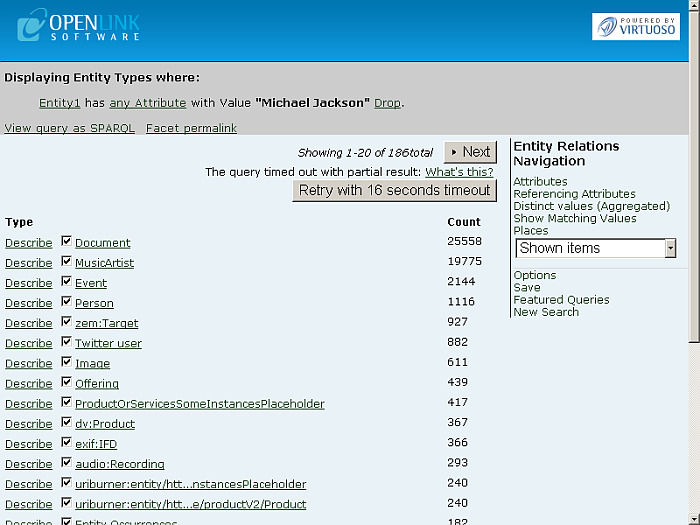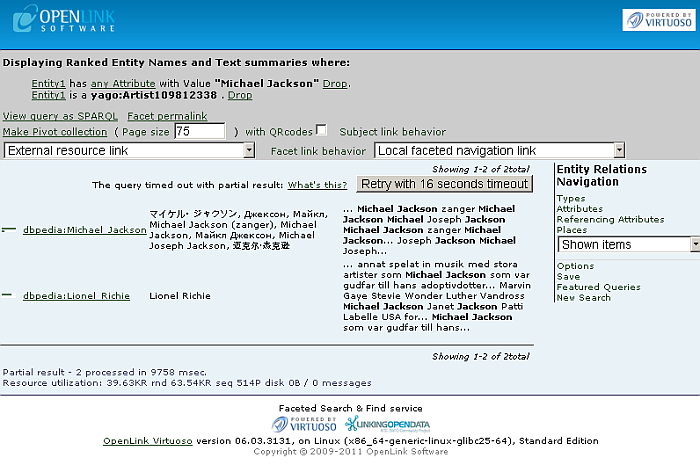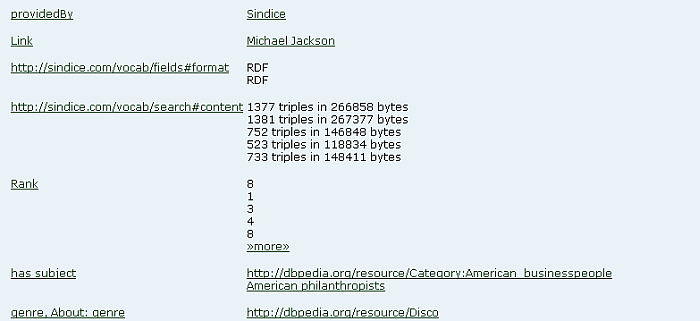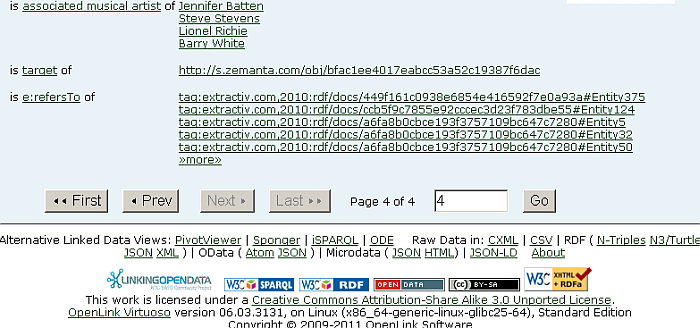16.11.6. Usage Statistics
-
Use the Faceted Browser Search and Find User Interface to search for information on "Michael Jackson":
Figure 16.138. Usage Statistics

-
Results of the following form should be returned for the network resource data being fetched.
Figure 16.139. Usage Statistics

-
Click the "Types" link under "Entity Relations Navigation".
-
Results about "Michael Jackson" as Type/Label/Count list should be displayed:
Figure 16.140. Usage Statistics

-
You can navigate amongst the search results pages by using the "Prev" and "Next" buttons. Click for ex. "Next":
Figure 16.141. Usage Statistics

-
Click a type link, for ex.:
http://dbpedia.org/class/yago/Artist109812338
-
Should be shown type results and:
Displaying Ranked Entity Names and Text summaries where: Entity1 has any Attribute with Value "Michael Jackson" Drop. Entity1 is a yago:Artist109812338 . Drop
Figure 16.142. Usage Statistics

-
Click the link:
dbpedia:Michael_Jackson
-
Results about "Michael Jackson" as Attribute/Value list should be presented:
Figure 16.143. Usage Statistics

Figure 16.144. Usage Statistics

Figure 16.145. Usage Statistics

Figure 16.146. Usage Statistics

-
You can navigate amongst the search results pages by using the "First", "Prev", "Next" and "Last" buttons. Click for ex. "Last":
Figure 16.147. Usage Statistics

Figure 16.148. Usage Statistics

-
"Metadata" tab.
-
Results of usage statistics for "Michael Jackson" grouped in 4 tabs should be shown:
-
Referenced by Graphs: shows how many times the URI is found as subject in the relevant graph(s):
SPARQL SELECT ?g count (*) where { graph ?g { <URI> ?p ?o } } group by ?g order by desc 2 limit 20Figure 16.149. Usage Statistics

-
Source Graphs: shows how many times the URI is found as object in the relevant graph(s):
SPARQL SELECT ?g count (*) where { graph ?g { ?s ?p <URI> } } group by ?g order by desc 2 limit 20Figure 16.150. Usage Statistics

-
Direct co-references: shows results as subject and calculated rank, based on running transitive closure over owl:sameAs of the URI in subject or object:
SPARQL SELECT ?syn ( sql:rnk_scale (<LONG::IRI_RANK> (?syn))) where { { SELECT ?s ?syn where { {?syn owl:sameAs ?s } union {?s owl:sameAs ?syn} } } option (transitive, t_distinct, t_min (0), T_in (?s), t_out (?syn)) . filter (!isliteral (?syn) && ?s = <URI> ) } order by desc 2 limit 20Figure 16.151. Usage Statistics

-
Indirect co-references: shows expanded results for objects concur with the URI by IFP:
SPARQL SELECT distinct ?syn ?p ?o (sql:rnk_scale (<LONG::IRI_RANK> (?syn))) where { <URI> ?p ?o . filter (0 != (<LONG::bif:rdf_is_sub> ("b3sifp", ?p, lod:ifp_like, 3))) . ?syn ?p ?o . } order by desc 4 limit 20Figure 16.152. Usage Statistics

-
